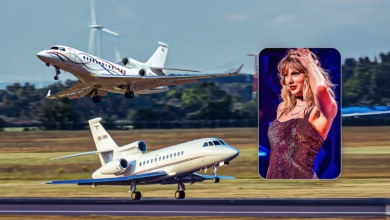Fastest Fighter Jet in the World: Speed Monsters of Sky

Introduction:
The fastest fighter jet is a true beast of the sky, built for speed, power, and unmatched performance. These jets are designed to outfly enemies, complete missions in record time, and push the limits of technology.
In this blog, we will explore the fastest fighter jets in history, their top speeds, and what makes them so special. From military legends to modern marvels, these jets have shaped air combat in incredible ways. Let’s dive in!
What is the Fastest Fighter Jet? The Ultimate Speed King
The fastest fighter jet ever built is the Mikoyan MiG-25 Foxbat. It can fly at a top speed of Mach 3.2 (2,190 mph). This jet was created by the Soviet Union to chase and destroy high-speed threats. Even today, it remains one of the quickest jets ever made.
Speed is important for fighter jets because it helps pilots avoid danger and strike targets quickly. A fast jet can escape enemy missiles, reach battle zones in minutes, and complete missions before enemies react. That’s why engineers always try to make jets faster.
While the MiG-25 holds the record for an operational fighter jet, experimental planes have gone even faster. Some test jets have reached Mach 5 or more, pushing the limits of technology. In the future, we may see even faster jets in the sky.
Top 10 Fastest Fighter Jets Ever Built (With Speeds & Details)
Here are the top 10 fastest fighter jets and their speeds:
- Mikoyan MiG-25 Foxbat – Mach 3.2 (2,190 mph)
- Mikoyan MiG-31 Foxhound – Mach 2.83 (1,900 mph)
- McDonnell Douglas F-15 Eagle – Mach 2.5 (1,650 mph)
- Sukhoi Su-27 – Mach 2.35 (1,600 mph)
- MiG-23 Flogger – Mach 2.35 (1,553 mph)
- Grumman F-14 Tomcat – Mach 2.34 (1,544 mph)
- Mikoyan MiG-29 Fulcrum – Mach 2.3 (1,520 mph)
- IAI Kfir – Mach 2.3 (1,520 mph)
- Lockheed Martin F-22 Raptor – Mach 2.25 (1,500 mph)
- McDonnell Douglas F-4 Phantom II – Mach 2.23 (1,470 mph)
Each of these jets was designed for different missions. Some were built for air combat, while others were made for quick interceptions. Their high speeds make them powerful in battle.
Even though some of these jets are old, they are still used in some countries. Their speed, power, and weapons keep them useful today. Engineers continue to improve fighter jets to make them even faster.
How Fighter Jets Reach Supersonic Speeds: The Science of Speed
Fighter jets need powerful engines and special designs to go super fast. Most high-speed jets use afterburners, which give them an extra boost. This helps them break the sound barrier and fly faster than Mach 1.
Air resistance is another big challenge. If a plane is not designed well, the air will slow it down. That’s why fighter jets have sharp noses and sleek bodies. This shape cuts through the air easily, reducing drag.
Fuel is also important. High-speed jets burn a lot of fuel in a short time. Some jets have extra fuel tanks or can refuel in the air to keep flying longer. Without enough fuel, even the fastest jet would have to slow down.
Fastest Fighter Jets vs. Bombers: Which Planes Rule the Skies?

Fighter jets and bombers have different jobs in war. Fighters are built for speed and agility, while bombers are made to carry heavy weapons. But which one is better in battle?
Fighter jets are fast and can dodge enemy attacks. They are used to protect airspace, fight enemy jets, and stop bombers from reaching their targets. A fast fighter jet can chase and shoot down enemy planes before they cause damage.
Bombers, on the other hand, are slow but carry powerful bombs. They can destroy enemy bases, ships, and other big targets. Some modern bombers use stealth technology to avoid radar detection, making them harder to stop.
Both types of planes are important. In a real war, fighters and bombers often work together to complete missions. Speed is a big advantage, but it’s not the only thing that matters.
Can Any Fighter Jet Beat the Speed of Sound? (Yes, and Here’s How!)
Many fighter jets can fly faster than sound. The speed of sound (Mach 1) is about 767 mph (1,235 km/h) at sea level. Some jets go two or three times faster than this!
To break the sound barrier, jets need:
- Powerful engines – More thrust means more speed.
- Afterburners – Extra fuel boosts speed for short bursts.
- Aerodynamic design – A smooth shape reduces air resistance.
- Strong materials – High-speed jets face extreme heat and pressure.
Breaking the sound barrier was a big achievement in aviation history. Today, many military jets do it easily. Future jets might even reach Mach 5 or higher!
The Role of Speed in Modern Air Combat: Why It Still Matters
Speed helps fighter jets in many ways. A faster jet can attack first, escape danger, and complete missions quickly. That’s why the fastest fighter jets are still highly valued in modern air forces.
High-speed jets can chase and intercept enemies before they reach important targets. This makes them useful for defense missions. If an enemy launches an attack, a fast jet can stop them before they cause damage.
But speed alone is not enough. Modern fighter jets also need stealth, powerful weapons, and smart technology. A jet that is both fast and smart is the best choice for any military.
Top Countries with the Fastest Fighter Jets: Who Leads the Race?
Some countries build faster jets than others. The top nations with the fastest fighter jets include:
- United States – F-22 Raptor, F-15 Eagle
- Russia – MiG-25 Foxbat, MiG-31 Foxhound
- China – J-20 Mighty Dragon
- India – HAL Tejas
- France – Dassault Rafale
Each country focuses on different strengths. Some jets are built for speed, while others focus on stealth or weapons. The race to build the best fighter jet never stops!
Future of Hypersonic Fighter Jets: Will We See Mach 10 Planes?

The future of air combat could be hypersonic jets. These planes would fly at Mach 5 or more, making them almost impossible to stop.
Challenges of Hypersonic Fighter Jets:
- Extreme heat – The faster a plane flies, the hotter it gets.
- Fuel limits – Hypersonic speeds use fuel quickly.
- Control issues – High speeds make turning harder.
New Hypersonic Projects:
- NASA’s X-43 – Reached Mach 9.6 (fastest aircraft ever).
- China’s hypersonic tests – New projects under development.
- US Air Force Hypersonic Jet – Plans for a Mach 5+ fighter.
If engineers solve these challenges, the fastest fighter jets of the future will be faster than ever before!
Conclusion
The fastest fighter jets are amazing machines that push the limits of speed and power. They help pilots complete missions quickly, avoid danger, and protect the skies. Over the years, engineers have made jets faster, stronger, and smarter. These planes have changed air combat and will continue to improve in the future.
New technology may bring even faster jets, maybe even hypersonic ones. As the world’s air forces compete to build the best fighter jets, we will see even greater advancements. Speed is important, but a great fighter jet also needs powerful weapons, stealth, and smart technology. The future of air combat looks exciting!
FAQs
Q: What is the fastest fighter jet in the world?
A: The fastest fighter jet is the Mikoyan MiG-25 Foxbat, which can fly at Mach 3.2 (2,190 mph).
Q: Can any fighter jet fly faster than the speed of sound?
A: Yes! Many fighter jets fly faster than sound. The speed of sound is Mach 1 (767 mph), and some jets reach Mach 2 or more.
Q: Why are fighter jets so fast?
A: Fighter jets are fast to catch enemies, avoid attacks, and complete missions quickly. Speed helps them win battles in the air.
Q: Will there be faster fighter jets in the future?
A: Yes! Engineers are working on hypersonic jets that could fly at Mach 5 or more. These jets will be much faster than today’s fighters.
Q: Which country has the fastest fighter jets?
A: The United States, Russia, and China have some of the fastest jets. Each country builds different jets for different missions.



